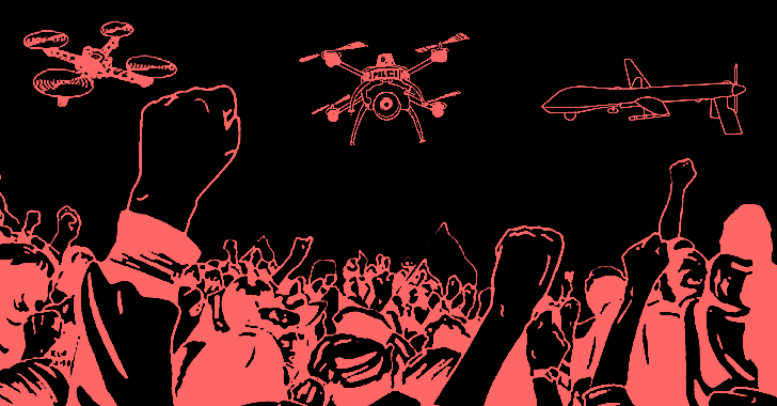Since the first known deployment of a domestic drone to aid in police work made headline news in 2011, civil liberties advocates have been warning of the slippery slope upon which we’ve descended.
In that North Dakota case, drone surveillance led to the arrest of three suspected cattle thieves; police used the justification of an armed standoff and even a potential bomb threat to call in a Predator B drone. Naturally, once this precedent was established, at least two dozen more drone surveillance flights were documented in the subsequent months.
To be sure, the debate about the use of police drones has become more commonplace, but the fact remains that dozens of police forces around the country have either shown interest, or have taken the next stop to prepare the framework for the release of drones on a variety of missions, even including drones equipped with tasers and other “non-lethal” weapons.
Of course the “slippery slope theory” can’t be invoked without a slick starting place, which makes the latest news from Los Angeles, California troubling despite some pointed restrictions stated by Los Angeles County Sheriff Jim McDonnell.
During a recent news conference, the sheriff unveiled a $10,000 per-unit unmanned vehicle that he claims is a necessary tool for the most extreme situations that pose a risk to police (see video here). Based upon a specific certificate of authorization with the FAA, parameters will be set, as recounted by Capt. Jack Ewell and reported by the Los Angeles Times, with my emphasis added:
Under the agreement, sheriff’s officials have to notify the FAA anytime the drone is airborne, and provide information about where it will be flying and for what purpose, Ewell said. The Sheriff’s Department had to submit a list of tasks the drone would be used for, and that list does not include surveillance, according to Ewell.
“The [unmanned aircraft system] will not be used to spy on the public,” McDonnell said, repeating the promise several times. “Our policy forbids using [it] for random surveillance.”
However, it turns out that the reassuring statement does not factor into the actual agreement; it is merely a promise made by the police themselves, and not subject to FAA oversight.
Ian Gregor, a spokesman for the FAA, said any agreement between his agency and the Sheriff’s Department would not actually govern how police use the device.
“We don’t prohibit the type of flight activity that a law enforcement agency conducts,” he said via e-mail. “We do have limitations on the conditions under which a drone can fly.”
The general concern over police spying has been addressed vigorously by the Los Angeles public for several years. In 2014, an organization called Stop LAPD Spying Coalition was formed specifically to document their resistance to secret drone surveillance. Late last year, the group condemned the police commission as “an affront to the principles of democracy,” after the commission closed a session to the public and refused to allow comment on police proposals.
However, the LAPD has thus far appeared to address the overwhelming concern of citizens by not employing two Draganflyer X6 drones that they already obtained from the Seattle PD in 2014. At the time, the LAPD stated in no uncertain terms that the public must be in agreement with their use:
“If we do deploy these, not sure we ever will, it’ll be based on a strict set of written guidelines approved by the police commission,” said Cmdr. Andy Smith. “Absent approval from the police commission and public acceptance, we’re not going to use them. Chief Beck said if it compromises public trust, we won’t use them.”
(Source)
RFID Scan Blockers – Available for Free (Ad)
Public trust indeed had been compromised, as the LA Times also reported, so one has to hope that this is what they have been trying to rectify.
In 2012, a single-engine aircraft spent nine days circling Compton, recording low-resolution images of the city. Compton officials were not notified of the surveillance, and when the program came to light in 2014, several residents, including Mayor Aja Brown, expressed dismay.
Nevertheless, broken trust is very difficult to repair.
 It doesn’t appear that the anti-spying coalition has responded yet to the latest announcement of police drone use but, according to their website, they do have meetings scheduled over the next couple of weeks where perhaps this issue will be addressed.
It doesn’t appear that the anti-spying coalition has responded yet to the latest announcement of police drone use but, according to their website, they do have meetings scheduled over the next couple of weeks where perhaps this issue will be addressed.
In the meantime, it is a reminder to citizens across the United States to engage their local police in order to begin a dialogue about the growth of drone surveillance technology. Raise your concerns and demand the restrictions you deem necessary, now, before those decisions are made for you.
The Electronic Frontier Foundation has put together a list of drone questions for your local police department and a convenient method for reporting your findings to the Foundation. Once submitted they can help guide you through the proper channels of government in order to formally protest any plans to use drone surveillance in your area.
Nicholas West writes for ActivistPost.com. This article can be freely republished in part or in full with author attribution and source link.


Yet those drones don’t “see” the illegals that rob, rape, murder, and stand in multiple lines to “vote” democrat…..Los Angeles being a sanctuary city and all.
Because one of the biggest government gangs are so so so trustworthy